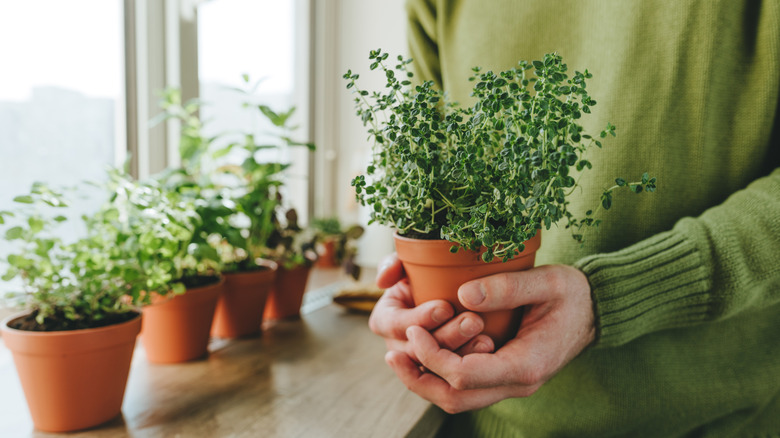DIY A Stunning Countertop Herb Planter With An Unexpected Kitchen Item
We may receive a commission on purchases made from links.
When looking for imaginative ideas to grow your herbs inside, you'll often find that a most unexpected kitchen item can be put to good use to create a stunning countertop herb planter. For example, you can reuse tea tins for an indoor herbal garden, or you can make a beautiful hanging herb garden using empty cans and string. Another clever idea comes from YouTuber @astar's place, who uses an old three-tier wire fruit stand and turns it into a fantastic, compact, edible garden. It's a great alternative if you don't have a large windowsill that can accommodate multiple pots. This means that even if you're short of gardening space outdoors, you can still cultivate all the herbs you love to use for your cooking right there in your kitchen.
Although you may have a fruit stand around the house or come across one at a yard sale, you can also purchase a basket that suits your needs exactly, such as this lovely REGAL TRUNK & CO. Two-Tier Fruit Basket, with deep compartments to hold enough potting mix to support plant growth. Another attractive option is this Gourmet Basics by Mikasa Loop and Lattice Two-Tier Basket, which has nice deep baskets.
How to make your eye-catching herb planter
All you'll need is the fruit stand, landscape fabric, premium potting soil, sphagnum moss, and a selection of small herb plants. Some of the herbs that will grow best in your kitchen include parsley, oregano, thyme, chives, and basil. Cut the fabric to size so it fits neatly inside each basket, ensuring it reaches the top of the baskets to ensure the potting mix is contained. Cut a slit from the edge to the center to fit it around the central post if your stand has one. While the video shows the addition of stones on top of the fabric, this is not recommended as water is likely to pool on top of the stones, which may be detrimental to your plants. A better idea is to use a permeable, non-woven geotextile fabric that allows adequate drainage and place a tray under the planter to catch excess water. Or you could use something like burlap instead.
Fill each basket with your soil, then add a sphagnum moss layer on top. This not only looks appealing but also helps to keep moisture in. Then, it's just a case of popping all your herbs into the soil where they look the best — low-growing ones in the bottom tier and taller varieties like rosemary in the top one. You can even put in a few small lettuce seedlings and some colorful edible flowers, such as pansies and violas, and sprinkle a few micro-green seeds over the moss.
